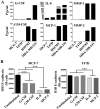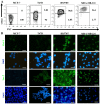Evidence of lateral transmission of aggressive features between different types of breast cancer cells
- PMID: 29048610
- PMCID: PMC5643070
- DOI: 10.3892/ijo.2017.4128
Evidence of lateral transmission of aggressive features between different types of breast cancer cells
Abstract
Breast cancer (BrC) is a major public health problem worldwide. The intra-tumoral heterogeneity and tumor cell plasticity importantly contribute to disease progression and treatment failure. However, the dynamic interactions between different tumor clones, as well as their contribution to tumor aggressiveness are still poorly understood. In this study, we provide evidence of a lateral transmission of aggressive features between aggressive and non-aggressive tumor cells, consisting of gain of expression of cancer stem cell markers, increased expression of CXCL12 receptors CXCR4 and CXCR7 and increased invasiveness in response to CXCL12, which correlated with high levels of secretion of pro-inflammatory mediators G-CSF, GM-CSF, MCP-1, IL-8 and metalloproteinases 1 and 2 by the aggressive cells. Noteworthy, we found no evidence of a TGF-β participation in the inducible-invasive phenotype. Altogether, our results provide evidence of communication between tumor cells with different potentials for aggressiveness, which could influence intra-tumoral population dynamics promoting the emergence of clones with novel functions. Understanding these interactions will provide better targets for diagnosis, prognosis and therapeutic strategies.
Figures
















Similar articles
-
Androgen receptor and chemokine receptors 4 and 7 form a signaling axis to regulate CXCL12-dependent cellular motility.BMC Cancer. 2015 Mar 31;15:204. doi: 10.1186/s12885-015-1201-5. BMC Cancer. 2015. PMID: 25884570 Free PMC article.
-
Inflammatory CXCL12-CXCR4/CXCR7 axis mediates G-protein signaling pathway to influence the invasion and migration of nasopharyngeal carcinoma cells.Tumour Biol. 2016 Jun;37(6):8169-79. doi: 10.1007/s13277-015-4686-2. Epub 2015 Dec 29. Tumour Biol. 2016. PMID: 26715277
-
Prognostic significance of CXCL12, CXCR4, and CXCR7 in patients with breast cancer.Int J Clin Exp Pathol. 2015 Oct 1;8(10):13217-24. eCollection 2015. Int J Clin Exp Pathol. 2015. PMID: 26722521 Free PMC article.
-
The chemokine receptors CXCR4/CXCR7 and their primary heterodimeric ligands CXCL12 and CXCL12/high mobility group box 1 in pancreatic cancer growth and development: finding flow.Pancreas. 2015 May;44(4):528-34. doi: 10.1097/MPA.0000000000000298. Pancreas. 2015. PMID: 25872129 Review.
-
Biological/pathological functions of the CXCL12/CXCR4/CXCR7 axes in the pathogenesis of bladder cancer.Int J Clin Oncol. 2017 Dec;22(6):991-1000. doi: 10.1007/s10147-017-1187-x. Epub 2017 Oct 11. Int J Clin Oncol. 2017. PMID: 29022185 Review.
Cited by
-
The role of granulocyte colony‑stimulating factor in breast cancer development: A review.Mol Med Rep. 2020 May;21(5):2019-2029. doi: 10.3892/mmr.2020.11017. Epub 2020 Mar 10. Mol Med Rep. 2020. PMID: 32186767 Free PMC article. Review.
-
Cancer Biology, Epidemiology, and Treatment in the 21st Century: Current Status and Future Challenges From a Biomedical Perspective.Cancer Control. 2021 Jan-Dec;28:10732748211038735. doi: 10.1177/10732748211038735. Cancer Control. 2021. PMID: 34565215 Free PMC article.
-
17-β Estradiol up-regulates energy metabolic pathways, cellular proliferation and tumor invasiveness in ER+ breast cancer spheroids.Front Oncol. 2022 Nov 7;12:1018137. doi: 10.3389/fonc.2022.1018137. eCollection 2022. Front Oncol. 2022. PMID: 36419896 Free PMC article.
-
Chloroquine sensitizes MDA-MB-231 cells to osimertinib through autophagy-apoptosis crosstalk pathway.Breast Cancer (Dove Med Press). 2019 Jul 23;11:231-241. doi: 10.2147/BCTT.S211030. eCollection 2019. Breast Cancer (Dove Med Press). 2019. PMID: 31839713 Free PMC article.
-
Dual Functions of T Lymphocytes in Breast Carcinoma: From Immune Protection to Orchestrating Tumor Progression and Metastasis.Cancers (Basel). 2023 Sep 28;15(19):4771. doi: 10.3390/cancers15194771. Cancers (Basel). 2023. PMID: 37835465 Free PMC article. Review.
References
-
- Sørlie T, Perou CM, Tibshirani R, Aas T, Geisler S, Johnsen H, Hastie T, Eisen MB, van de Rijn M, Jeffrey SS, et al. Gene expression patterns of breast carcinomas distinguish tumor subclasses with clinical implications. Proc Natl Acad Sci USA. 2001;98:10869–10874. doi: 10.1073/pnas.191367098. - DOI - PMC - PubMed
MeSH terms
Substances
LinkOut - more resources
Full Text Sources
Other Literature Sources
Medical
Miscellaneous

